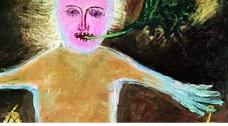Antoni Tapies
dal 16/2/2004 al 9/5/2004
Segnalato da
16/2/2004
Antoni Tapies
Museu d'Art Contemporani de Barcelona MACBA, Barcelona
Retrospective. A retrospective exhibition containing a selection of over 120 works by Antoni Tapies (Barcelona, 1923), from the forties to the present, some of them little known until now. Through paintings, objects, sculptures and drawings, this show, the most complete ever, will be exploring Tapies' material nature as a fundamental principle for understanding his work, his influence and his place in the history of contemporary art.

Retrospective
A retrospective exhibition containing a selection of over 120 works by Antoni TÃ pies (Barcelona, 1923), from the forties to the present, some of them little known until now. Through paintings, objects, sculptures and drawings, this show, the most complete ever, will be exploring TÃ pies' material nature as a fundamental principle for understanding his work, his influence and his place in the history of contemporary art. The public has until now remained largely unaware of some of the works as they belong to private collectors who have rarely loaned them for display in exhibitions. The fundamental feature of those 'walls' is not the visual aspects derived from the qualities of the materials or the shades of colour. Neither the object represented nor the signs scrawled on them are important in themselves. The essence of these works are the intentional elements with which the artist informs the material, the shapes it acquires, the signs printed on it.
The artist's aim is for the spectator to perceive the material in a state of constant movement and change, a state opposed to the fragmentation and compartmentalisation of the contemporary world. Astride two worlds, one linked to the great rhetorical or idealistic figures of the middle of the century and the other which opened paths towards new artistic practices more connected with activity and process, TÃ pies' work is still relevant today due to its radical ambiguity. In all its manifestations, whether painting, assemblage, ceramics or graphics, his output always maintains a tension between its object and material aspects (his paintings are both paintings and objects, and his sculptures are both objects and paintings) and the ones concerned with the composition itself.
TÃ pies work was very early on associated with informalism and was for decades the subject of stereotyped interpretations and commonplaces. Yet, far from constituting a repertoire of more or less spontaneous gestures captured on the canvas, his works reveal a strict internal logic whose nature escapes formalist analysis and hagiographic disquisitions.
e readings have been all the more incongruent in that the artist s efforts were directed towards revealing and exploring the problems and relationships of painting rather than solving them. TÃ pies was not so much looking for a real pictorial language as its confrontation; rather than talking of the triumph of modern painting, we should be considering its impossibility. Despite the centrality of Antoni TÃ pies work in Catalan art and culture of the second half of the 20th century and still today, it remains caught up in the wake generated around the artist s person.
This exhibition explores the material nature of TÃ pies work as a fundamental principle for placing him in the history of contemporary art and for analysing the reasons why his presence has been so constant and obsessive in Catalan art from the 1950s to the present day. This exhibition is part of the Spanish Art Abroad programme, through which the Foreign Ministry, in association with the State Corporation for Cultural Action Abroad (SEACEX), organises a series of individual exhibitions of contemporary Spanish artists. When the exhibition closes at MACBA, a selection of eighty works will travel around other museums in Spain and abroad.
Presentation to the Media: February 16, 2004, 11.00 a.m.
Opening: February 17, 2004. 7.30 p.m.
Curator: Manuel Borja-Villel
Production: Museu d Art Contemporani de Barcelona (MACBA) - Ministerio de Asuntos Exteriores - Sociedad Estatal para la Acción Cultural Exterior (SEACEX)
MACBA
Plaza dels Angels 1
Barcelona



